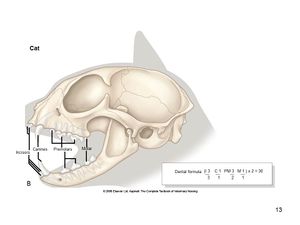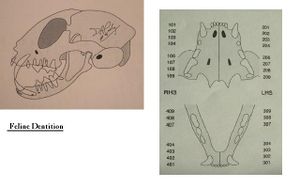Difference between revisions of "Dental Formula - Cat"
Fiorecastro (talk | contribs) |
|||
| (21 intermediate revisions by 3 users not shown) | |||
| Line 1: | Line 1: | ||
| − | + | {{OpenPagesTop}} | |
| + | ==Introduction== | ||
| + | Cats are toothless at birth. '''Deciduous''' teeth are complete and functional within 2 months of birth. '''Permanent''' teeth are complete and functional by the end of the 6th month. | ||
| − | |||
| + | Formula for '''deciduous''' teeth: 2 (i3/3 c1/1 p3/2) | ||
| − | + | Formula for '''permanent''' teeth: 2 (I3/3 C1/1 P3/2 M1/1) | |
| − | + | ===Incisors=== | |
| + | |||
| + | Cats have six incisors in the maxilla and six in the mandible. | ||
| + | |||
| + | ===Canines=== | ||
| + | |||
| + | There is one canine tooth in each quadrant of the mouth. These teeth have a single root. | ||
| + | |||
| + | ===Premolars=== | ||
| + | |||
| + | Cats have three premolars in the maxilla and two in the mandible on each side. | ||
| + | The maxillary 1st premolar is normally missing and the 2nd premolar is very small and often not visible. The 3rd maxillary premolar is present. The 4th premolar is termed the carnassial tooth. | ||
| − | + | The mandibular 1st and 2nd premolars are normally missing. The 3rd and 4th premolars are present. | |
| − | |||
| − | |||
===Molars=== | ===Molars=== | ||
| + | |||
| + | Cats have one molar in each quadrant of the mouth. The maxillary molars form a grinding surface. The mandibular molars are called the carnassial teeth. | ||
A decrease in the number of '''molars''' leaves the cat with a shearing bite, rather than wider cusps for grinding. | A decrease in the number of '''molars''' leaves the cat with a shearing bite, rather than wider cusps for grinding. | ||
| + | <center><gallery widths=300px heights=250px> | ||
| + | Image:Aspinall Slide13.JPG|<small>Image from [http://www.elsevierhealth.co.uk/veterinary-nursing/spe-60136/ Aspinall, The Complete Textbook of Veterinary Nursing], Elsevier Health Sciences, ''All rights reserved''</small> | ||
| + | Image:Feline Dentition.jpg|Feline Dentition - Copyright Nottingham 2008 | ||
| + | </gallery></center> | ||
| + | {{Lisa Milella reviewed | ||
| + | |date = July 28, 2013}} | ||
| + | |||
| + | {{Waltham}} | ||
| + | |||
| + | ==Webinars== | ||
| + | <rss max="10" highlight="none">https://www.thewebinarvet.com/dentistry/webinars/feed</rss> | ||
[[Category:Teeth - Anatomy & Physiology]] | [[Category:Teeth - Anatomy & Physiology]] | ||
[[Category:Cat - Alimentary System]] | [[Category:Cat - Alimentary System]] | ||
| − | [[Category: | + | [[Category:Oral Examination]] |
| + | [[Category:Lisa Milella reviewed]] | ||
| + | [[Category:Waltham reviewed]] | ||
Latest revision as of 17:12, 2 November 2022
Introduction
Cats are toothless at birth. Deciduous teeth are complete and functional within 2 months of birth. Permanent teeth are complete and functional by the end of the 6th month.
Formula for deciduous teeth: 2 (i3/3 c1/1 p3/2)
Formula for permanent teeth: 2 (I3/3 C1/1 P3/2 M1/1)
Incisors
Cats have six incisors in the maxilla and six in the mandible.
Canines
There is one canine tooth in each quadrant of the mouth. These teeth have a single root.
Premolars
Cats have three premolars in the maxilla and two in the mandible on each side.
The maxillary 1st premolar is normally missing and the 2nd premolar is very small and often not visible. The 3rd maxillary premolar is present. The 4th premolar is termed the carnassial tooth.
The mandibular 1st and 2nd premolars are normally missing. The 3rd and 4th premolars are present.
Molars
Cats have one molar in each quadrant of the mouth. The maxillary molars form a grinding surface. The mandibular molars are called the carnassial teeth.
A decrease in the number of molars leaves the cat with a shearing bite, rather than wider cusps for grinding.
Image from Aspinall, The Complete Textbook of Veterinary Nursing, Elsevier Health Sciences, All rights reserved
| This article was expert reviewed by Lisa Milella BVSc DipEVDC MRCVS. Date reviewed: July 28, 2013 |
| Endorsed by WALTHAM®, a leading authority in companion animal nutrition and wellbeing for over 50 years and the science institute for Mars Petcare. |
Webinars
Failed to load RSS feed from https://www.thewebinarvet.com/dentistry/webinars/feed: Error parsing XML for RSS

